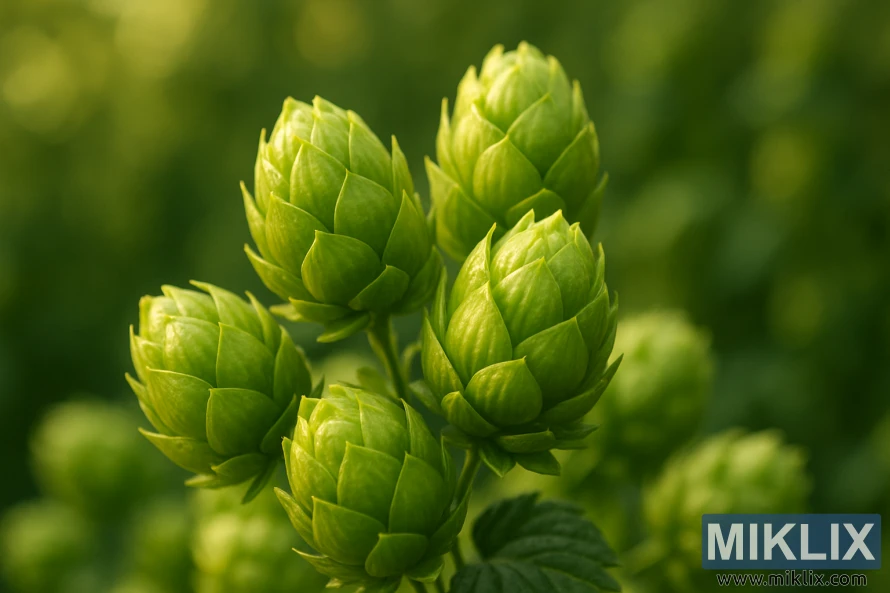Image: Fresh Hersbrucker Hops
Published: September 14, 2025 at 8:56:16 AM UTC
Last updated: September 27, 2025 at 8:19:50 AM UTC
Close-up of freshly harvested Hersbrucker hops with vibrant green cones and glowing lupulin glands, evoking citrus, spice, and earthy brewing notes.
The image presents a radiant and intimate view of Hersbrucker hops, their clustered cones rising proudly from the bine with a vibrancy that seems to glow in the warm afternoon light. Each hop cone is tightly packed, its papery bracts overlapping in precise, natural symmetry, creating a layered effect that speaks to both fragility and strength. Their vivid green coloration exudes freshness, a signal of their peak condition just before harvest, while the sunlight caresses their surfaces, highlighting subtle gradations of tone from soft lime to deeper emerald. The cones themselves appear almost sculptural, their pointed tips angled upward like nature’s own architecture, a form both utilitarian and beautiful in its function.
Upon closer inspection, one can almost sense the hidden richness within—the delicate lupulin glands, barely glimpsed beneath the translucent layers of bracts, glimmer with golden oils that carry the soul of the hop. These resins contain the promise of transformation, the alchemy of brewing in its rawest form. Imagined scents rise from the cones: floral notes that recall meadows in bloom, a hint of spice that teases the senses, a whisper of earth grounding the bouquet in nature’s depth. A faint suggestion of citrus dances at the edges, crisp and clean, while undertones of herbal character balance the profile. It is this complexity that makes Hersbrucker hops so cherished, their aromatic subtlety forming the backbone of countless classic European lagers, where restraint and refinement are held above brash intensity.
The background is rendered in a soft, hazy blur, suggesting the larger hop field from which these cones have been carefully gathered. The shallow depth of field draws the eye exclusively to the foreground cluster, isolating them in sharp focus and allowing every ridge, fold, and curve of the cones to be admired. Yet the green blur behind them is more than atmosphere—it carries with it the suggestion of abundance, of row upon row of towering hop bines stretching across the countryside, swaying gently in a summer breeze. It situates these individual cones within their broader ecosystem, reminding us that they are not isolated marvels but part of a living, breathing landscape where cultivation and care are inseparable from the final product.
The interplay of natural light across the scene deepens its tactile quality. Golden sunlight pours in from one side, casting shadows that define the three-dimensionality of the cones while also imbuing them with warmth. It is a light that conveys ripeness, the culmination of a growing season’s patient tending, and hints at the fleeting nature of harvest—when hops are at their aromatic peak and must be gathered quickly to preserve their precious oils. The cones seem to radiate vitality, their glow almost suggestive of the energy they will later release into the boil, where their oils dissolve into wort, imparting not only bitterness but also the subtle, delicate aromatics for which Hersbrucker is famed.
The mood of the composition is both serene and celebratory. It captures a moment of stillness in the life of the plant, freezing in time the fragile beauty of cones that, within days, may be plucked, dried, and destined for a brewer’s kettle. It is a portrait of potential, poised between the natural world and human craft. These hops represent more than an agricultural product—they embody centuries of brewing heritage, the ongoing dialogue between farmer and brewer, plant and palate. To gaze upon them in this luminous close-up is to witness not just their physical form, but the story they carry: of soil, sunlight, tradition, and the artistry that transforms them into the subtle spice and floral elegance of a well-crafted beer.
The image is related to: Hops in Beer Brewing: Hersbrucker

